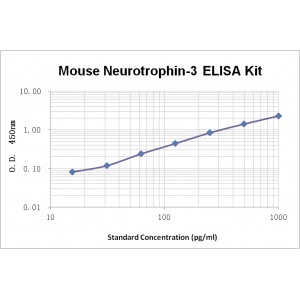More info
Assay Range | 15.6-1,000 pg/mL |
Sensitivity | 2.0 pg/mL |
Size | 96T |
Storage | Store at 2 - 8ºC. Keep reconstituted standard and detection Ab at -20 ºC |
Assay Principle | Sandwich ELISA |
Sample Volume | 100 µL final volume, dilution factor varies on samples |
Detection Method | Chromogenic |
Kit Components
1. Recombinant Mouse Neurotrophin-3 standard: 2 vials
2. One 96-well plate coated with Mouse Neurotrophin-3 Ab
3. Sample diluent buffer: 12 mL - 1
4. Detection antibody: 130 µL, dilution 1:100
5. Streptavidin-HRP: 130 µL, dilution 1:100
6. Antibody diluent buffer: 12 mL x1
7. Streptavidin-HRP diluent buffer: 12 mL x1
8. TMB developing agent: 10 mL x1
9. Stop solution: 10 mL x1
10. Washing solution (20x): 25 mL x1
Background
Neurotrophin3 (NT3), also known as HDNF, Nerve growth factor 2, or NGF-2, is a member of the NGF family in which at least four proteins including NGF, BDNF, NT3, and NT4/5 have been identified. All of these proteins have six conserved cysteine residues that are required for the formation of three disulfide bonds and all share approximately 55% amino acid (aa) sequence identity. The NT3 is synthesized as a 257 aa precursor protein containing a signal peptide and a proprotein that are cleaved to yield the 119 amino acid residue mature NT3. The human mature NT3 protein is identical to mouse and rat NT3. NT3 is expressed in specific neurons or non-neuronal tissues such as cerebellum, hippocampus, placenta, heart, skin, and skeletal muscle.
The receptor tyrosine kinase TrkC is a specific receptor for NT3. NT3 is also capable of binding to TrkB, a common receptor for BDNF and NT4. In addition, NT3 can bind with low affinity to the low affinity NGF receptor. NT3 plays a key role in the differentiation and survival of target neurons in peripheral and central nervous systems.


